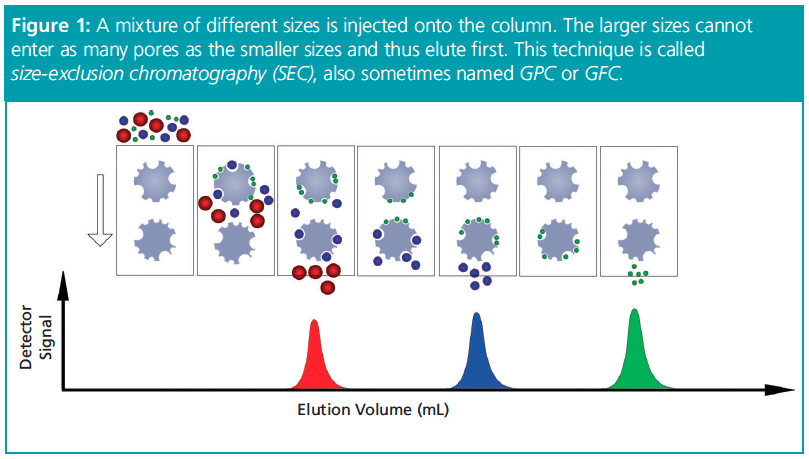Size Exclusion Chromatography (SEC HPLC)
What is size exclusion chromatography?
Size exclusion chromatography (SEC HPLC), also known as gel filtration chromatography, is a chromatographic method that separates molecules based on their particle size (actually particle's Stokes radius). It is usually applied to large molecules or macromolecular complexes such as proteins and polymers.
What is the principle of size exclusion chromatography?
Typically, when samples enter into the column, different molecules will have different elution rates. The small particles trapped into the stationary phase pore system can go through a total volume (the sum of the entire pore volume and the inter-particle volume). They will elute for longer time. In the contrary, larger molecules simply pass by some stationary phase pores as they are too large to enter them. Therefore larger molecules elute through the column faster than smaller ones. That is to say, the smaller the molecule is, the longer the retention time will be.
Each size exclusion column has a range of molecular weight for separation. The exclusion limit for upper end of the column is that the molecules weight is too large to be trapped in the stationary phase. The lower end of the range is defined the molecular weight of the molecules which is small enough to enter all pores of the stationary phase. It should be noticed that particles of the same size or similar size may not separate from each other by SEC.
What is size exclusion chromatography used for?
This technique is widely used for the separation and purification of proteins. According to standard proteins, this technique is also useful for determination of molecular weight (Mw) and particle size. SEC is the official technique.
Size exclusion chromatography (SEC or SEC HPLC) for measurement of protein absolute molecular weight, structure, size and conformation.
Size Exclusion Chromatography (SEC or SEC-HPLC) is an analytical technique that separates dissolved macromolecules by size based on their elution from columns filled with a porous gel.
When SEC is coupled with light scattering, viscometer and concentration detectors (known as triple detection), it can measure absolute molecular weight, molecular size, and intrinsic viscosity and generate information on macromolecular structure, conformation, aggregation and branching.
By using SEC to measure molecular weight and these other properties, scientists can characterize molecules such as proteins, synthetic polymers, and natural polymers such as polysaccharides. See Figure 1
For all of these molecules, these parameters relate very closely to their performance in countless applications. With this technique:
- Biochemists can understand protein oligomerization, aggregation, conjugation and conformation.
- Polymer chemists can control polymer strength, toughness and performance.
- Pharmaceutical producers can tailor the behavior of products such as eye-drops.
- Food producers can better understand product performance and quality.
For polymer and protein characterization, in polymer, food, pharmaceutical and biopharmaceutical research, Malvern Panalytical offers a range of SEC systems or individual SEC detectors, including SEC-MALS, to suit your application needs.



